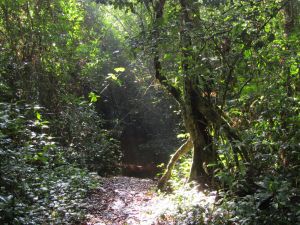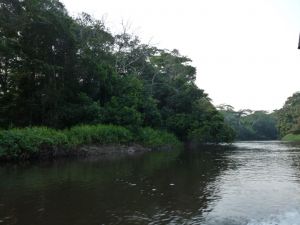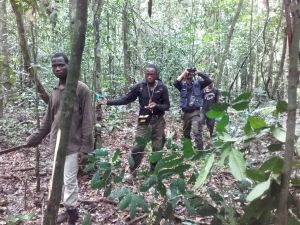Salonga National Park (South Block)
Central Africa > Democratic Republic of the Congo > Salonga National Park (South Block)
Français | Português | Español | Bahasa Indonesia | Melayu
Summary
- Bonobos (Pan paniscus) are present in the south block of Salonga National Park.
- It has been estimated that 9,246 (CI: 3,596-20,720) individuals occur in the site.
- The bonobo population trend is stable.
- The site has a total size of 17,127 km².
- Hunting is the most important threat to bonobos; expansion of land for agriculture and disease transmission threaten the bonobo population to a lower extent, but may increase in severity in the nearby future.
- Conservation activities have focused on biomonitoring, anti-poaching patrols and surveillance with SMART software application, education and awareness raising, and presence of researchers and staff.
- Salonga is the only national park in the geographic range of bonobos.
Site characteristics
Salonga National Park (SNP) is the largest protected area of pristine rainforest in the African continent (33,500 km²). Located south of the Congo river, in the Democratic Republic of the Congo, it is a UNESCO World Heritage site and a stronghold for many endangered species. SNP, is divided into two blocks, North and South, separated by a 45 km wide inhabited buffer zone. Since 2015, the park is co-managed by the Congolese Institute for Nature Conservation (ICCN) in collaboration with the World Wide Fund for Nature (WWF).
Table 1. Basic site information for Salonga National Park (South Block)
| Species | 'Pan paniscus |
| Area | 17,127 km² |
| Coordinates | Lat: -2.533783 , Lon: 20.907380 |
| Type of site | Protected area (National Park) |
| Habitat types | Subtropical/tropical moist lowland forest, Subtropical/tropical swamp forest, Savanna, Agricultural land, Wetlands (lakes, rivers, streams, bogs, marshes) |
| Type of governance |
IUCN habitat categories Site designations
Ape status
After the first confirmation of bonobo presence (Kano 1984) only a few studies have estimated bonobo abundance in SNP’s southern block. Reinartz et al. (2006), conducted preliminary surveys in the South block between 2000 and 2002. Between 2002 and 2006, Grossmann et al. (2008) used a combination of recces (across the whole block) and line transects (over 5,500 km²) to estimate bonobo density and abundance using Distance Sampling. They reported an average density of 0.39 weaned bonobo/km² for the whole block. Then, between 2016 and 2018, Bessone et al. (2020), surveyed the whole block using a combination of Camera-Trap Distance Sampling (CTDS) and SCNC. Results from CTDS returned an estimated density of 0.54 weaned bonobo/km², with preliminary SCNC results providing estimates similar to those obtained by Grossmann et al. (2008) using the same method (Bessone et al. in preparation). Accordingly, the bonobo population trend of SNP block South was stable over the past decade.
Table 2. Ape population estimates reported for Salonga National Park (South Block)
| Species | Year | Occurrence | Encounter or vistation rate (nests/km; ind/day) | Density estimate [ind./ km²] (95% CI) | Abundance estimate (95% CI) | Survey area | Sampling method | Analytical framework | Source | Comments | A.P.E.S. database ID |
|---|---|---|---|---|---|---|---|---|---|---|---|
| Pan paniscus | 2016-2018 | 0.54 (0.21-1.21) | 9,246 (3,596 - 20,720) | 17,000 km², SNP South block | Point transects | Bessone et al. 2020 | |||||
| Pan paniscus | 2015 | 3.19 | 0.38 (0.15 - 0.96) | 1,042 (419 - 2,591) | 2,700 km², Salonga Lokofa | Line transects | WCS 2015 | ||||
| Pan paniscus | 2006 | 2.20 | 0.51 (0.28 - 1.01) | 1,282 (699 - 2,533) | 2,500 km², Salonga Iyaelima | Line transects | Grossmann et al. 2008 | ||||
| Pan paniscus | 2005 | 1.15 | 0.27 (0.14 - 0.56) | 541 (281 - 1,119) | 2,000 km², Salonga Lokofa | Line transects | Grossmann et al. 2008 | ||||
| Pan paniscus | 2000 | 8 | 1.36 | <10 km², Salonga Beminyo | Line transects | Reinartz et al. 2006 | |||||
| Pan paniscus | 2000-2002 | 24.4 | 2.78 | 25 km², Salonga Lokofa | Line transects | Reinartz et al. 2006 |
Threats
The bonobo is a taboo animal in some part of the South block, particularly (but not exclusively) in the Iyaelima area (Thompson et al. 2008), where the highest bonobo densities of the site have been observed, despite the presence of 8 permanent villages (Grossmann et al. 2008). However commercial hunters reach very deep into the site and hunting remains the main threat to the ape population (Hart et al. 2008). In addition, the frequent human presence within the site exposes bonobos to human-transmitted diseases such as the Ebola Haemorrhagic Fever. Two recent Ebola outbreaks were recorded north of the site, in Mbandaka (2018) and Boende (2014). Both are major centres in the region, with constant movement of people and traders from, and to, these towns. In spite of growing human populations, forest clearing for agricultural purposes is still concentrated outside the site, and the surface of cultivated areas inside the block has not changed since 2003 (IUCN 2020).
Table 3. Threats to apes reported for Salonga National Park (South Block)
| Category | Specific threats | Threat level | Description | Year of threat |
|---|---|---|---|---|
| 10 Geological events | Absent | |||
| 12 Other threat | Absent | |||
| 5 Biological resource use | 5.1 Hunting & collecting terrestrial animals | High (more than 70% of population affected) | SNP has a history of intense poaching for ivory and bushmeat. Bonobos are taboo in some area of the Park, but are nevertheless hunted for commercial purposes, demand for bonobo meat and parts coming from cities outside the block. Signs of both traditional and professional hunting can be found everywhere in the block. (Hart et al., 2008; Bessone et al., in preparation). | Ongoing (2020) |
| 2 Agriculture & aquaculture | 2.1 Annual & perennial non-timber crops | Low (up to 30% of population affected) | A small proportion of the site is concerned, with slash and burn concentrated outside the site borders. | Ongoing (2020) |
| 8 Invasive & other problematic species, genes & diseases | 8.4 Pathogens | Low (up to 30% of population affected) | The frequent presence of humans, particularly (but not solely) due to the presence of 8 villages within the site borders, exposes bonobos to human-transmitted diseases such as Ebola Haemorrhagic Fever, with two recent outbreaks north of the Park, in Mbandaka (2018) and Boende (2014). | Ongoing (2020) |
| 1 Residential & commercial development | Unknown | |||
| 3 Energy production & mining | Unknown | |||
| 4 Transportation & service corridors | Unknown | |||
| 6 Human intrusions & disturbance | Unknown | |||
| 7 Natural system modifications | Unknown | |||
| 9 Pollution | Unknown | |||
| 11 Climate change & severe weather | Unknown |
Conservation activities
Table 4. Conservation activities reported for Salonga National Park (South Block)
| Category | Specific activity | Description | Implementing organization(s) | Year of activity |
|---|---|---|---|---|
| 2 Counter-wildlife crime | 2.3 Conduct regular anti-poaching patrols | Regular patrols are conducted by the Park management and have significantly increased over the past 5 years (IUCN 2020). | Ongoing (2020) | |
| 2 Counter-wildlife crime | 2.7 Provide better equipment (e.g., guns) to anti-poaching ranger patrols | Park management (IUCN 2020). | Ongoing (2020) | |
| 2 Counter-wildlife crime | 2.8 Provide training to anti-poaching ranger patrols | Park management (IUCN 2020). | 2018 and 2020 | |
| 2 Counter-wildlife crime | 2.11 Implement monitoring surveillance strategies (e.g., SMART) or use monitoring data to improve effectiveness of patrols | Park management (IUCN 2020). | Ongoing (2020) | |
| 4 Education & awareness | 4.1 Educate local communities about apes and sustainable use | Park management (IUCN 2020) | Ongoing (2020) | |
| 5 Protection & restoration | 5.2 Legally protect ape habitat | National Park since 1970. | Ongoing (2020) | |
| 8 Permanent presence | 8.3 Permanent presence of staff/manager | Ongoing (2020) |
Conservation activities list (Junker et al. 2017)
Challenges
Table 5. Challenges reported for Salonga National Park (South Block)
| Challenges | Specific challenges | Source | Year(s) |
|---|---|---|---|
| Not reported |
Enablers
Table 6. Enablers reported for Salonga National Park (South Block)
| Enablers | Specific enablers | Source | Year(s) |
|---|---|---|---|
| 1 Site management | |||
| 2 Resources and capacity | |||
| 3 Engaged community | |||
| 4 Institutional support | |||
| 5 Ecological context | |||
| 6 Safety and stability |
Research activities
Reinartz et al. (2006; 2008), Grossmann et al. (2008), Maisels et al. (2010), WCS (2015) and Bessone et al. (2020) conducted surveys estimating bonobo and other species densities. Hart et al. (2008) reported on the impact of human activities on bonobos, and Thompson et al. (2008) on traditional culture of the Iyaelima people, with regard to bonobo conservation.In the buffer zone, west of the site, the LuiKotale Bonobo Project is conducting research on habituated bonobos, focusing on all aspects of bonobos’ ecology, physiology, behaviour and evolutionary history, as well as on ethnobotany (Hohmann and Fruth, 2003).
Documented behaviours
Table 7. Behaviours documented for Salonga National Park (South Block)
| Behavior | Source |
|---|---|
| Not reported |
Exposure to climate change impacts
External links
Salonga National Park UNESCO World Heritage
Salonga National Park IUCN World Heritage Outlook
Relevant datasets
References
Bessone, M., Kühl, H. S., Hohmann, G., Herbinger, I., N'Goran, K. P., Asanzi, P., . . . Beka, B. (2020). Drawn out of the shadows: Surveying secretive forest species with camera-trap distance sampling. Journal of Applied Ecology, 57(5), 963-974.
Bessone, M., Booto, L., Santos, A. R., Kühl, H. S., & Fruth, B. (2021). No time to rest: How the effects of climate change on nest decay threaten the conservation of apes in the wild. PloS one, 16(6), e0252527.
Fruth, B., Hickey, J. M., Andre, C., Furuichi, T., Hart, J., Hart, T., . . . Reinartz, G. (2016). Pan paniscus. The IUCN Red List of Threatened Species 2016: e.T15932A102331567.
Grossmann, F., Hart, J. A., Vosper, A., & Ilambu, O. (2008). Range occupation and population estimates of bonobos in the Salonga National Park: application to large-scale surveys of bonobos in the Democratic Republic of Congo. In The Bonobos (pp. 189-216): Springer.
Hart, J. A., Grossmann, F., Vosper, A., & Ilanga, J. (2008). Human hunting and its impact on bonobos in the Salonga National Park, Democratic Republic of Congo. In The Bonobos (pp. 245-271): Springer.
Hohmann, G., & Fruth, B. (2003). Lui Kotal: a new site for field research on bonobos in the Salonga National Park. Pan Africa News, 10(2), 25-27.
IUCN (2020). Salonga National Park - 2020 Conservation Outlook Assessment. IUCN World Heritage Outlook: https://worldheritageoutlook.iucn.org.
Kano, T. (1984). Distribution of pygmy chimpanzees (Pan paniscus) in the central Zaire basin. Folia primatologica, 43(1), 36-52.
Thompson, J. M., Nestor, L. M., & Kabanda, R. B. (2008). Traditional land-use practices for bonobo conservation. In The Bonobos (pp. 227-244): Springer.
Maisels, F., Nkumu, P., Bonyenge, A., & Naky, P. (2010). Salonga National Park, Democratic Republic of Congo: Terrestrial Wildlife and Human-Impact Monitoring Programme. Survey Report–Eastern Sector of Park. Unpublished report, Wildlife Conservation Society, New York.
Reinartz, G. E., Isia, I. B., Ngamankosi, M., & Wema, L. W. (2006). Effects of Forest Type and Human Presence on Bonobo ( Pan paniscus) Density in the Salonga National Park. International Journal of Primatology, 27(4), 1229-1231.
Reinartz, G. E., Guislain, P., Bolinga, T. M., Isomana, E., Inogwabini, B.-I., Bokomo, N., . . . Wema, L. W. (2008). Ecological factors influencing bonobo density and distribution in the Salonga National Park: applications for population assessment. In The Bonobos (pp. 167-188): Springer.
WCS (2015). Survey of the Lokofa Block of the Salonga National Park: preliminary report. Wildlife Conservation Society, Kinshasa, DRC.
Page created by: Mattia Bessone Date: NA



